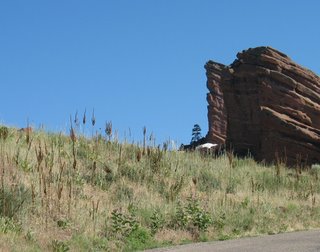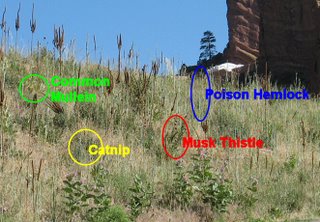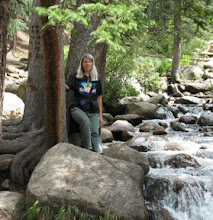
Ecology moves on, creating new plant communities where the old originals have lost vigor, or resistance. So we discovered on Tuesday's hike in Red Rocks. In the shadow of Ship Rock, we found this new plant association I'd never seen before, though the elements will no doubt be familiar to you, as they are to all of us! This is the kind of plant community that makes Europeans feel welcome when they visit our unfamiliar habitats.
 Let's take a closer look... Of course, the familiar brown stalks are last year's seed shoots of Common Mullein (Verbascum thapsus). Can you see its light green rosettes ready to bloom this year? In the foreground is the clump of Showy Milkweed we discussed in yesterday's post. There's also a consistent, light brown background matrix of Cheatgrass, already seeded and dried for this season (and a great fire hazard).
Let's take a closer look... Of course, the familiar brown stalks are last year's seed shoots of Common Mullein (Verbascum thapsus). Can you see its light green rosettes ready to bloom this year? In the foreground is the clump of Showy Milkweed we discussed in yesterday's post. There's also a consistent, light brown background matrix of Cheatgrass, already seeded and dried for this season (and a great fire hazard). In case you can't make out the rest, here's a labeled version. What makes a road bank of Mullein and Cheatgrass unusual to me? Its pals... Consorting here are darker green clumps of Catnip (Nepeta cataria), a patch of Musk Thistle (Carduus nutans), and pale blue stalks of Poison Hemlock (Conium maculatum), which normally prefers a little more moisture.
In case you can't make out the rest, here's a labeled version. What makes a road bank of Mullein and Cheatgrass unusual to me? Its pals... Consorting here are darker green clumps of Catnip (Nepeta cataria), a patch of Musk Thistle (Carduus nutans), and pale blue stalks of Poison Hemlock (Conium maculatum), which normally prefers a little more moisture.Exiled in America from Russia, Vladimir Nabokov was struck with nostalgia at the sight of clover and dandelion in Oregon. These and the plants mentioned here, especially the Common Mullein, have gained a reputation as "white man's footsteps," simply because they've become so ubiquitous here in the "New World." Charles Darwin once teased American botanist Asa Gray because our wimpy native flora was being trounced by imports from Britain and Europe.*
Finches and Fritillaries enjoy the flowers of the Musk Thistle (and probably the Catnip as well when it blooms), so our natives are adapting to some of these new food sources. It's exciting that something has also started to focus on the Poison Hemlock, because every one of the bluish stalks in this picture is stripped of leaves. Bee Lady and I think this is a surprise, not a planned "biologicial control" introduction, but we're still trying to figure out who is virtually wiping out the Poison Hemlock here in Red Rocks, and whether this is happening elsewhere as well. Any ideas, please share them!
*See The Ends of the Earth, page 103, Donald Worster, Ed. for these stories from Alfred W. Crosby's book on Ecological Imperialism.

No comments:
Post a Comment